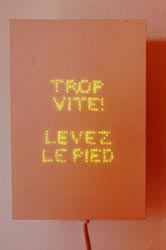


|
|
CURATORIAL PROJECTS
Ron Haselden, TROP VITE!, in Anxious Words
2001
mise en scene
Centre for Freudian
Analysis and Research, London
artists: a Love Laboratory, barrett_forster, Neal Beggs, Paul Carter,
Monika Duda, Lisa Fielding-Smith, Jane Henderson Mawby, Tim Meara, Anne
Redmond, Roxy Walsh, Charlie Youle
This is not my story or yours, but it might be. Imagine this: a man
walks into a bar, he sees a woman at the bar whom he thinks is very
attractive, he remarks on this to his friends and declares his attention
to approach, his friends tell him she is not a woman but a man, and
his attraction goes no further. What happens to his desire? Where does
it go? It remains, but cannot be acted upon, and must wait for another,
a more 'correct' situation, if it is to be played out. Desire is always
directed to another, object or subject. Sexual pleasure is intimately
entwined with the Other, who is not always another individual, who may
be no more than a prop for a fantasy (barrett_foster) . For a man, substitute
a momentary relinquishing of masculinity (Tim Meara) or a tender mockery
(Roxy Walsh); substitute a woman or a series of women (Monika Duda);
for a woman or a man, put in place an object, a sequinned sleeping bag
(Neal Beggs), an interminable coil of knitting (Jane Henderson Mawby)
a re-presented text (Charlie Youle), a melancholy screening (a Love
Laboratory), an indeterminate body in a poodle suit (Lisa Fielding-Smith);
imagine the site of a missed encounter (Paul Carter) or the nostalgic
failure of a love relation (Anne Redmond). This exhibition emphasises
the foreignness of our fantasies, structured by a language that does
not seem our own; indeed, our fantasies may be those of another, whom
we can no longer recognise. All the works address the idea of a mise-en-scene
in the engagement with an image at the level of desire. Something is
played out, from a script that exists in the unconscious.
2000
Anxious Words
Waterstones, Piccadilly, London
artists: Neal Beggs, Mark Beever, Debbie Booth, Nathalie de Briey, Pavel
Büchler, Thomas A. Clark, Tom Dale, Frédérique Decombe,
Patricio Grosse Forester, Maria Fusco, Belinda Guidi, Liz Hall, Lucy
Harrison, Ron Haselden, Julia Heinrich, Jane Henderson, Kevin Kelly,
Tony Kemplen, Roberto Martinez, Tim Meara, Simon Morris, Georgia Russell,
George Shaw, Nadine Stephenson, Joanne Strange
1999
there is no sexual relation
Centre for Freudian
Analysis and Research, London
A Disturbance of Memory on the Acropolis
6 Feb 1999 - 6 Mar 1999
Centre for Freudian
Analysis and Research
The 6th CFAR exhibition based on psychoanalytic inquiries & texts,
curated by Sharon Kivland with Danuza Machado.
artists: Andrew Bannister • Ricardo Bloch • Lucy Harrison
• Ron Haselden • Gill Houghton • Charles Jeffrey •
Paul Kipps • Nayan Kulkarni • Enda Mullen • Juliette
Soubrier • Benjamin Swaim • Steve Swindells • Peter
Willis
A Disturbance Of Memory On The Acropolis is the sixth exhibition in
the CFAR series. It is also the title of a paper Freud wrote in 1936,
as an open letter to Romain Rolland, the French author and pacifist,
on the occasion of his seventieth birthday. Freud is eighty years old
at the time of writing and claims that 'his powers of production are
at an end'. He recalls an event of 1904 which he did not understand
at the time and has kept recurring to him. In Trieste with his brother,
they determine to go to Corfu but are told by their host it will be
too hot and they should go to Athens instead. They are depressed, any
change of plan seems impractical, but they succeed in booking tickets
for Athens. When Freud arrives in Athens and stands on the Acropolis
he is surprised to find himself thinking: 'So all this really does exist,
just as we learnt at school!' His surprise is twofold; firstly, that
something unbelievable exists, and secondly, that its existence should
have been in doubt. His depression in Trieste and the idea on the Acropolis
seem to be connected.
Freud's pleasure in a journey to Athens - a journey he did not believe
possible either while in Trieste or in the past, when he doubted he
should ever see Athens - is marred by his arrival there. His sensation
is one of unreality, a feeling he has somehow transposed to the past.
He also feels guilty, his shame of a son who has surpassed the limitations
of his father, and the shame of his assumption of superiority, for Athens
would not have meant much to his father who lacked a classical education.
The artists in A Disturbance Of Memory On The Acropolis have responded
to the themes of Freud's text, to ideas of fraternal and filial relations,
deferral and anxiety, memory and its (re)constructions, with new, specially
conceived works.
1998
Ornament in the Field of Vision, CFAR, London
Disquieting Strangeness, CFAR, London
The Impossible, CFAR, London
1997
Lexicon, Centre for Freudian Research and Analyis, London
A little object, Centre for Freudian Research and Analysis, London
1993
Hôtel des Voyageurs, France (publication)
Les Voyageurs, Galerie du Chai, St. Brieuc, France
1991
The Centre of the World, John Hansard Gallery, Southampton (catalogue)
1988
The Consumption of Elements, Chisenhale Gallery, London
Fragments of False Houses, Pomeroy Gallery, London (catalogue)
Monumental Works, with Ian Walker, St. George's Church,
London, (publication)
1987
A System of Support, Kettle's Yard, Cambridge
1986
The Illuminations, Camerawork, London (catalogue)
|
|
